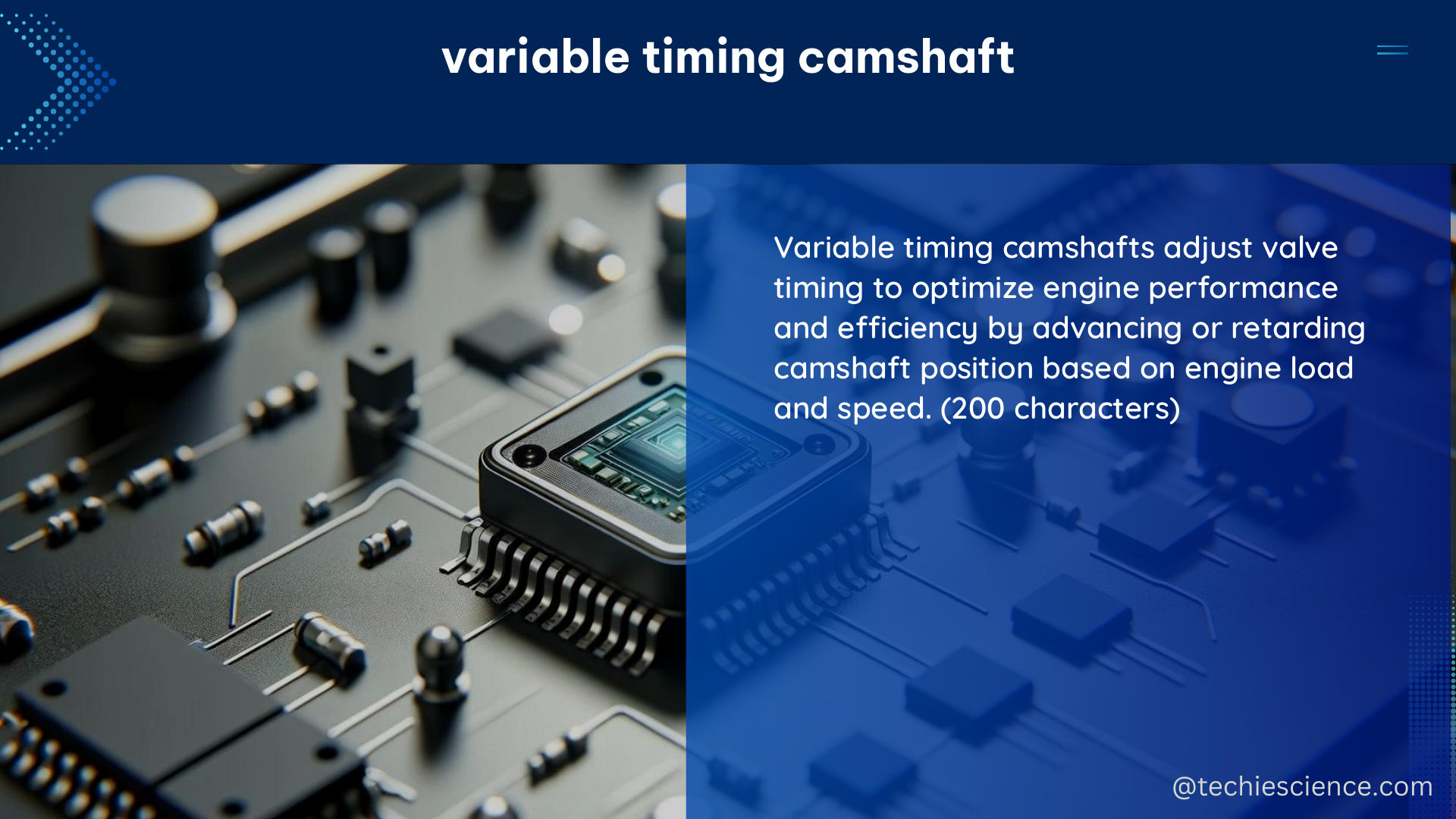Variable Timing Camshaft (VTC) is a technology that allows the engine’s camshaft timing to be adjusted dynamically, enabling optimized valve timing for different operating conditions. This advanced feature can significantly improve engine performance, fuel economy, and emissions, making it a crucial component in modern engine design. In this comprehensive guide, we will delve into the technical details, quantifiable data, and practical applications of VTC, providing a valuable resource for enthusiasts, mechanics, and engineers alike.
Understanding the Fundamentals of Variable Timing Camshaft
The core principle of VTC is the ability to adjust the camshaft’s position relative to the crankshaft, which in turn alters the timing of the engine’s intake and exhaust valves. This adjustment is achieved through the use of a VTC actuator, which is typically an oil control valve that regulates the flow of engine oil to a phasing mechanism within the camshaft.
Camshaft Timing and Its Impact on Engine Performance
The timing of the camshaft is crucial in determining the engine’s volumetric efficiency, which directly affects power output and fuel economy. By adjusting the camshaft timing, VTC can optimize the valve opening and closing events to match the engine’s operating conditions, such as load, speed, and temperature.
Quantifiable Data on Camshaft Timing Optimization
A study published in the journal Energy found that by optimizing the VVT parameters, the IMEP (Indicated Mean Effective Pressure) of the engine increased by 11.7%, leading to a significant boost in power performance. Additionally, a separate study comparing two small-capacity spark ignition engines revealed that the VVT engine had a 5.5% improvement in fuel economy compared to the non-VVT engine.
Adjusting Camshaft Position with VTC Devices

One of the key features of VTC is the ability to dynamically adjust the camshaft position to suit the engine’s operating conditions. This is typically achieved through the use of specialized devices, such as the CAMCON system, which can be integrated into the engine’s control system.
The CAMCON VTC Device
The CAMCON device is a popular solution for adjusting camshaft position in VTC-equipped engines. It takes in a VVT-i signal from the engine’s control unit and adjusts the camshaft position accordingly, with a resolution of up to 100 RPM.
Technical Specifications of the CAMCON Device
- Supply Voltage: 9-16V
- Consumption Current: 50mA
- Operating Temperature Range: -40°C to +85°C
- Intake Cam Phase Adjustment: ±60°C
- Exhaust Cam Phase Adjustment: ±45°C
Adjusting Camshaft Position with an Arduino Board
A project on the Arduino forum discussed the feasibility of adjusting the camshaft position using an Arduino board and a CAMCON device. The Arduino board can be programmed to interface with the CAMCON device, allowing for precise control over the camshaft timing based on engine speed and other parameters.
Detecting and Analyzing VTC Signals
Monitoring and analyzing the VTC signals is crucial for understanding the engine’s performance and diagnosing any issues. One method proposed in the literature involves the use of a shielded wire parallel to the sensor output wire, which is then connected to a combustion analyzer.
Valve Timing Sensor Detection using Conjugate Induction
The proposed method for detecting VVT signals is based on the principle of conjugate induction. By placing a shielded wire parallel to the signal output wire of the intake and exhaust cam sensors, the pulse voltage signals can be collected and processed by a combustion analyzer. This allows for the accurate detection of the intake and exhaust cam position sensors under specific operating conditions.
Advantages of the Conjugate Induction Method
- Non-invasive detection of VVT signals
- Ability to obtain signals from both intake and exhaust cam sensors
- Potential for integration with engine control and diagnostic systems
Advanced Applications and Future Developments of VTC
As engine technology continues to evolve, the applications and capabilities of VTC are expected to expand. Some potential future developments include:
- Integrated VTC systems with advanced engine control algorithms for optimized performance and efficiency
- Hybrid VTC systems that combine mechanical and electronic adjustments for increased precision and responsiveness
- Predictive VTC strategies that utilize machine learning and artificial intelligence to anticipate engine operating conditions and adjust camshaft timing accordingly
Conclusion
Variable Timing Camshaft is a powerful technology that enables engine manufacturers to optimize valve timing for improved performance, fuel economy, and emissions. By understanding the technical details, quantifiable data, and practical applications of VTC, enthusiasts, mechanics, and engineers can unlock the full potential of this advanced engine feature. This comprehensive guide has provided a wealth of information to help you navigate the world of VTC and stay ahead of the curve in engine optimization.
References
- Project: Variable valve timing adjustment – Arduino Forum. https://forum.arduino.cc/t/project-variable-valve-timing-adjustment/191656
- Variable Cam Timing and VE – HP Academy. https://www.hpacademy.com/forum/general-tuning-discussion/show/variable-cam-timing-and-ve/
- Quantitative study on influence factors of power performance of VVT engine. https://www.sciencedirect.com/science/article/abs/pii/S0360544218309708
- Fuel economy analysis of part-load variable camshaft timing strategies in two modern small-capacity spark ignition engines. https://www.sciencedirect.com/science/article/abs/pii/S030626191501507X
- How To Optimize Cam Lift Settings For Different Driving Conditions And Performance Goals. https://fastercapital.com/questions/how-to-optimize-cam-lift-settings-for-different-driving-conditions-and-performance-goals.html

The lambdageeks.com Core SME Team is a group of experienced subject matter experts from diverse scientific and technical fields including Physics, Chemistry, Technology,Electronics & Electrical Engineering, Automotive, Mechanical Engineering. Our team collaborates to create high-quality, well-researched articles on a wide range of science and technology topics for the lambdageeks.com website.
All Our Senior SME are having more than 7 Years of experience in the respective fields . They are either Working Industry Professionals or assocaited With different Universities. Refer Our Authors Page to get to know About our Core SMEs.